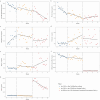Impact of zero-markup consumable policy and national procurement of coronary stents on hospitalization expenses: an interrupted time series analysis
- PMID: 39949557
- PMCID: PMC11821580
- DOI: 10.3389/fpubh.2025.1364116
Impact of zero-markup consumable policy and national procurement of coronary stents on hospitalization expenses: an interrupted time series analysis
Abstract
Background: After the successful reforms of drug pricing, China has implemented two significant reforms to reduce medical consumables expenses: the elimination of markup on prices (zero-markup policy) and the implementation of centralized procurement of high-value medical consumables (national procurement policy). The public hospitals in Guangdong province had implemented the zero-markup policy and national procurement policy for coronary stents. Currently, research on the zero-markup consumable policy and national procurement of coronary stents for medical consumables at the hospital level lacks analysis of changes in cost structures (other expenses) and studies on hospital response strategies.
Objective: This study aims to examine the effects of these reforms on hospitalization expenses for patients undergoing coronary stent implantation, including the specific changes in total hospitalization expenses, the component of total expenses, and the proportion of each expense category following the implementation of the reforms.
Methods: Data were obtained from the case management system of Guangdong Provincial Second People's Hospital in China. An interrupted time series design was employed to assess the impact of the reforms on inpatient expenses.
Results: Before the reforms, the median total hospitalization expense was 63,124.98 CNY, which decreased to 58,332.50 CNY during the zero-markup consumable policy period and further decreased to 48,266.34 CNY during the national centralized procurement policy period. The median expenses for western drugs, diagnostic tests, treatment, surgery, medical consumables, and other categories also displayed varying patterns. The expenses for medical consumables notably decreased from 39,119.52 CNY to 785.79 CNY after the implementation of the national procurement policy. The slope change of medical consumables expenses decreased by 600.81 CNY per month after the zero-markup policy, and the immediate effect of the national procurement policy resulted in a decrease of 32,160.81 CNY in median medical consumables expenses. Other expense categories experienced notable changes, with a substantial increase in the median of other expenses by 28,350.39 CNY during the national procurement policy period.
Conclusion: The reforms in medical consumables pricing and procurement have effectively reduced the cost of consumables for inpatients undergoing coronary stent plantation. The analysis of interrupted time series revealed that the elimination of the consumable markup policy had a limited effect on the level and trend of total hospitalization expenses. However, the implementation of the national procurement policy for coronary stents led to a significant reduction in medical consumables expenses. The study found that after the reform, hospitals mitigated revenue losses by increasing ambiguous other expenses, which may involve the shifting of medical consumable expenses in their accounting records.
Keywords: China; consumable; coronary stents; hospitalization expenses; national procurement; zero-markup policy.
Copyright © 2025 Wu, Wang, Yang, Liu, Zou, Li, Huang and Yu.
Conflict of interest statement
The authors declare that the research was conducted in the absence of any commercial or financial relationships that could be construed as a potential conflict of interest.
Figures




Similar articles
-
A comparative study of hospitalization costs of TKA inpatients before and after National Volume-based Procurement in Guangdong, China: an interrupted time-series analysis.Front Public Health. 2025 Jan 9;12:1468606. doi: 10.3389/fpubh.2024.1468606. eCollection 2024. Front Public Health. 2025. PMID: 39850863 Free PMC article.
-
Impacts of the zero mark-up drug policy on hospitalization expenses of COPD inpatients in Sichuan province, western China: an interrupted time series analysis.BMC Health Serv Res. 2020 Jun 8;20(1):519. doi: 10.1186/s12913-020-05378-0. BMC Health Serv Res. 2020. PMID: 32513170 Free PMC article.
-
Impacts of the zero mark-up policy on hospitalization expenses of T2DM and cholecystolithiasis inpatients in SC province, western China: an interrupted time series analysis.Front Public Health. 2023 Apr 28;11:1079655. doi: 10.3389/fpubh.2023.1079655. eCollection 2023. Front Public Health. 2023. PMID: 37188279 Free PMC article.
-
The impact of zero markup drug policy on patients' healthcare utilization and expense: An interrupted time series study.Front Med (Lausanne). 2022 Nov 15;9:928690. doi: 10.3389/fmed.2022.928690. eCollection 2022. Front Med (Lausanne). 2022. PMID: 36457568 Free PMC article.
-
Impacts of the Zero-Markup Drug Policy on Hospitalization Expenses of Patients with Stroke in Western China: An Interrupted Time Series Analysis.Risk Manag Healthc Policy. 2024 Apr 3;17:777-788. doi: 10.2147/RMHP.S456977. eCollection 2024. Risk Manag Healthc Policy. 2024. PMID: 38584876 Free PMC article.
References
MeSH terms
LinkOut - more resources
Full Text Sources

